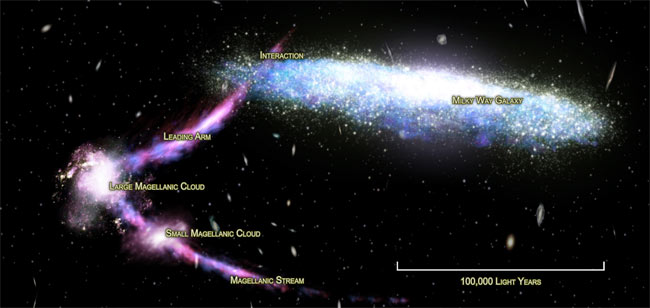Cosmic Finger Taps Our Galaxy's Shoulder

As ifreaching out with a come-hither motion, a giant gas finger emanating from two neighboringgalaxies has hooked into the starry disk of the Milky Way.
Thisextremity of hydrogen gas is actually the pointy end of the so-called LeadingArm of gas that streams ahead of two irregular galaxies called the Large andSmall Magellanic Clouds.
The fate ofthese nearby galaxies, which are impacted by the Milky Way's gravity, has beensomewhat of a mystery. The new finger findings suggest that the MagellanicClouds will eventually merge with the MilkyWay rather than zooming past.
Locatedabout 160,000 light-years from Earth, the Large Magellanic Cloud (LMC) is onlyone-twentieth the diameter of our galaxy and contains one-tenth as many stars.The SmallMagellanic Cloud resides 200,000 light-years from Earth and is about 100times smaller than the Milky Way.
?We?rethrilled because we can determine exactly where this gas is plowing into theMilky Way,? said research team leader Naomi McClure-Griffiths of CSIRO?sAustralia Telescope National Facility.
CalledHVC306-2+230, the gas finger is gouging into our galaxy's starry disk about70,000 light-years away from Earth. In the night sky, the contact point wouldbe nearest the Southern Cross.
Until lastyear, astronomers thought the Magellanic Clouds had orbited our galaxy manytimes. This scenario held a gloomy outlook for the clouds, which were said tobe doomed to be ripped apart and swallowed by the gravitational goliath.
Get the Space.com Newsletter
Breaking space news, the latest updates on rocket launches, skywatching events and more!
But thennew Hubble Space Telescope measurements revealed the clouds are paying our galaxya one-timevisit rather than being its lunch.
McClure-Griffiths'results, however, are more in line with the previous tale pegging the Milky Wayand the Magellanic Clouds as long-time companions. McClure-Griffiths remarksthat this isn't the final word and that both theories are still on the table.
By pointingout the spot of contact between the Leading Arm and our galactic disk, therecent study will help astronomers to predict where the clouds themselves willtravel in the future.
?We thinkthe Leading Arm is a tidal feature, gas pulled out of the Magellanic Clouds bythe Milky Way?s gravity,? McClure-Griffiths said. ?Where this gas goes, we?dexpect the clouds to follow, at least approximately.?
In thedistant future, the three galaxies could become one.
- Video: Fly Through the Milky Way and Beyond
- Vote: The Strangest Things in Space
- Image Gallery: Amazing Galaxies
Join our Space Forums to keep talking space on the latest missions, night sky and more! And if you have a news tip, correction or comment, let us know at: community@space.com.










